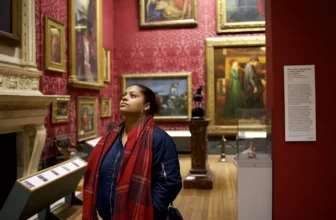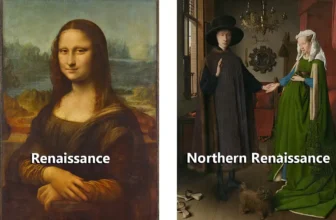The Calling of Saint Matthew by Caravaggio
A Moment That Changed Art History
One of the most compelling paintings of the Baroque era, The Calling of Saint Matthew by Michelangelo Merisi da Caravaggio, is not only a stunning masterpiece of dramatic realism and light but also a profound theological statement rendered in oil on canvas. Painted between 1599 and 1600, this work stands as a defining piece of Caravaggio’s career and a milestone in the evolution of Western art. The painting transcends its biblical narrative, offering rich symbolism, philosophical depth, and emotional resonance.
To understand the full impact of The Calling of Saint Matthew, we must delve into the story it tells, the way it was painted, the symbolic elements it incorporates, and the historical and religious context in which it was created.
What Is “The Calling of Saint Matthew” About?
The painting depicts a moment from the Gospel of Matthew (Matthew 9:9): Jesus sees Matthew (a tax collector, also called Levi) sitting at a table and says, “Follow me.” Matthew, surprised and hesitant, is caught in the exact moment of recognition and spiritual awakening.
Rather than a dramatic conversion scene, Caravaggio chooses to focus on the subtle, psychological drama: the tension of the instant when a person is faced with a life-altering choice. It’s not a depiction of divine thunder or grand gestures but of divine presence intruding into the everyday world.
Who Painted It and When?
Caravaggio painted The Calling of Saint Matthew in 1599–1600 as part of a larger commission for the Contarelli Chapel in the Church of San Luigi dei Francesi in Rome. This was one of three paintings (alongside The Martyrdom of Saint Matthew and Saint Matthew and the Angel) that narrate key episodes from the life of Saint Matthew, one of Christ’s twelve apostles and traditionally regarded as the author of the first Gospel.
Caravaggio was relatively young and still rising to prominence when he received the Contarelli Chapel commission. However, these paintings catapulted him into fame and established him as one of the most innovative painters of his generation.
How Was It Painted?
Caravaggio was known for his chiaroscuro technique, an intense interplay between light and dark that creates a sense of three-dimensional volume and emotional depth. The Calling of Saint Matthew is a quintessential example of this technique. He used live models, unidealized figures, and a dramatic contrast of shadows and light to make the scene feel immediate and real.
He often painted directly onto the canvas without preparatory sketches, which gave his works a raw, spontaneous quality. This was highly unusual at the time when detailed drawings and careful planning were standard practice.
Composition and Visual Analysis
The composition is deceptively simple but rich in narrative detail and psychological depth. The scene is set in a dimly lit, tavern-like room. Five men sit around a table, counting or collecting money. Christ enters from the right with Saint Peter slightly in front of Him. Christ’s hand is extended in a gesture of calling, directly pointing at Matthew.
But here’s where Caravaggio’s brilliance shines: we are not immediately sure who Matthew is. Is it the bearded man pointing at himself in astonishment? Is he saying, “Me?” Or is he pointing to the young man slumped over the coins?
This ambiguity forces the viewer into an act of interpretation, mirroring the painting’s theme of spiritual awakening. Most scholars agree the bearded man is Matthew, pointing to himself in shocked recognition, though the ambiguity reflects how Christ’s call can be both personal and universal.
Symbolism and Interpretation
The painting is teeming with symbolic meaning:
1. Light as Divine Grace
The shaft of light cutting diagonally across the painting, illuminating the faces of the figures and connecting Christ to Matthew, is not merely a source of physical illumination but represents divine grace. It echoes the idea that spiritual awakening is not of one’s own doing but initiated by God.
Interestingly, the light source appears to come from an unseen window, possibly above Christ’s head, symbolizing the heavenly origin of the call.
2. Gesture and Body Language
Christ’s hand gesture is nearly identical to that of Adam in Michelangelo’s Creation of Adam on the Sistine Chapel ceiling. This allusion suggests that Christ, as the “New Adam,” is bringing a new creation, a spiritual awakening rather than physical life.
Matthew’s gesture of pointing to himself is equally significant. It captures the human moment of confusion and awe when confronted with grace, salvation, or purpose.
3. Costumes and Setting
The men are dressed in contemporary 16th-century clothing, not biblical robes. Caravaggio brings the Gospel story into his own time and setting, reinforcing the timelessness and immediacy of Christ’s message. The setting is a shadowy, modest room, likely a tavern or counting house, a stark contrast to the divine figures entering the space.
This juxtaposition emphasizes Incarnation, the divine entering into the ordinary.
4. Dual Nature of Humanity
The painting also reflects on the duality of human nature. The younger figures, heads bent over the money, are indifferent to Christ’s presence. Matthew is at a crossroads, still attached to the material world but suddenly aware of a higher calling.
The Painting’s Theological Message
At its core, The Calling of Saint Matthew is about grace, conversion, and vocation. It dramatizes the moment of God’s intrusion into a life of sin and worldliness. Unlike other art that idealized saints, Caravaggio painted Matthew and his companions as ordinary, even flawed, people, tax collectors, seen as sinners in the Gospel context.
This made the painting not only relatable but also revolutionary. Caravaggio’s work suggests that sainthood is not the domain of the perfect but of those willing to answer the call.
What Is Happening in The Calling of Saint Matthew Painting?
In the freeze-frame moment depicted:
Christ, accompanied by Peter, has just entered the room.
He points at Matthew, calling him to leave his life of sin and follow Him.
Matthew, startled and confused, points to himself as if to say, “Are you talking to me?”
The other figures are engrossed in their money, oblivious to the spiritual event occurring.
The light from above cuts across the dark room, symbolizing the sudden, divine call.
This is not just a scene from history, it’s a portrait of inner conflict, revelation, and decision.
The Type of Art: Baroque Realism
The Calling of Saint Matthew is a textbook example of Baroque art, specifically Baroque realism. The Baroque style emphasized emotion, contrast, movement, and drama, all of which are present here.
Caravaggio’s use of tenebrism (extreme chiaroscuro) became a hallmark of Baroque painting and influenced countless artists, including Rembrandt and Velázquez. He rejected the idealized, mannerist style that was prevalent before him and instead focused on emotional realism, gritty detail, and human imperfection.
Caravaggio’s Revolutionary Approach
Caravaggio was considered controversial in his time, both personally and artistically. His commitment to realism, use of common people as models, and rejection of traditional aesthetics made him a radical figure in the art world.
In The Calling of Saint Matthew, he turned a familiar biblical episode into a psychological drama full of tension and uncertainty. This painting broke with tradition by portraying sacred subjects in a raw, intimate, and lifelike manner.
Influence
The impact of The Calling of Saint Matthew cannot be overstated. It helped solidify Caravaggio’s reputation and deeply influenced the direction of Baroque art. The emotional intensity, the use of light and dark, and the psychological realism would resonate through the works of later masters across Europe.
Artists like Rubens, Rembrandt, and Georges de La Tour took inspiration from Caravaggio’s innovations. The painting also influenced religious art, encouraging depictions of saints and biblical figures in more human and relatable forms.
Where Is The Calling of Saint Matthew Painting Today?
The Calling of Saint Matthew remains in its original location: the Contarelli Chapel in the Church of San Luigi dei Francesi (Saint Louis of the French) in Rome, Italy. This church, located near Piazza Navona, has become a pilgrimage site for art lovers, religious pilgrims, and tourists alike.
The painting still hangs alongside the two other Caravaggio masterpieces of Saint Matthew’s life, forming a stunning visual narrative of faith, martyrdom, and divine mission.
The Timelessness of the Call
Caravaggio’s The Calling of Saint Matthew endures not just because of its artistic brilliance but because of its existential relevance. Every person, at some point, faces a version of Matthew’s moment: a quiet but life-defining choice between complacency and calling, between the known and the divine unknown.
The painting doesn’t merely illustrate scripture, it invites the viewer into it. By situating the biblical moment in a contemporary setting, Caravaggio bridges the sacred and the secular, the ancient and the modern, the divine and the ordinary.
It is, ultimately, a painting about awakening, about the grace that breaks into even the darkest rooms of our lives with the simplest of gestures and the quietest of words: “Follow me.”




